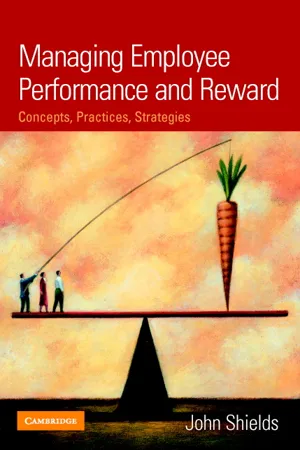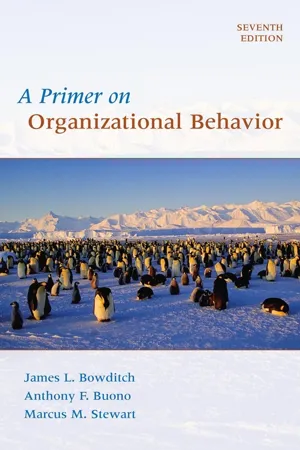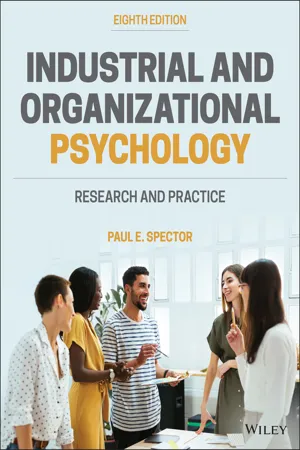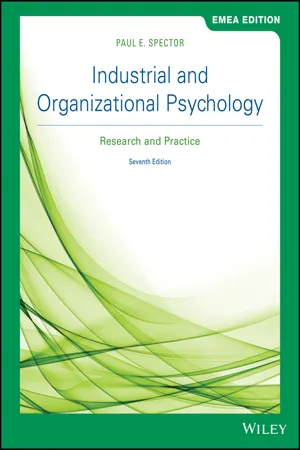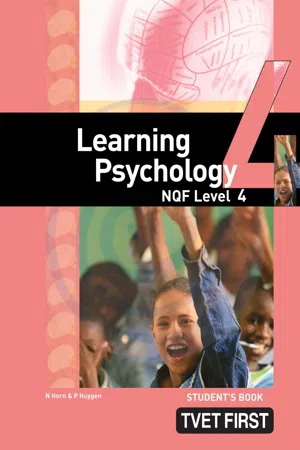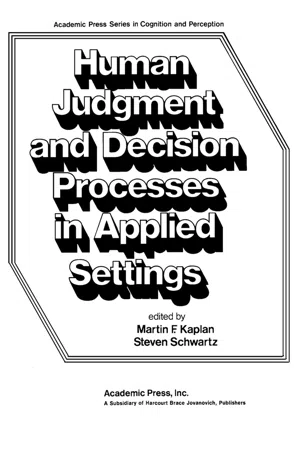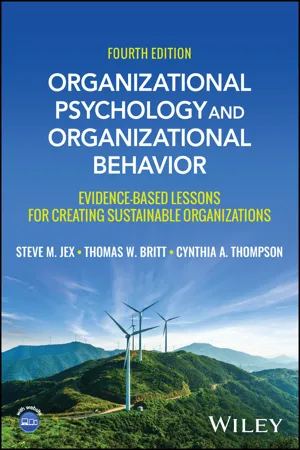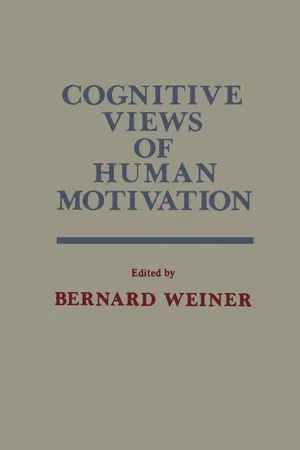Business
Expectancy Theory
Expectancy theory is a motivation theory that suggests people are motivated to act in a certain way based on the expectation of a desired outcome. It emphasizes the importance of individuals believing that their efforts will lead to successful performance and that this performance will be rewarded. The theory highlights the role of expectancy, instrumentality, and valence in driving motivation.
Written by Perlego with AI-assistance
Related key terms
1 of 5
12 Key excerpts on "Expectancy Theory"
- eBook - PDF
Managing Employee Performance and Reward
Concepts, Practices, Strategies
- John Shields(Author)
- 2007(Publication Date)
- Cambridge University Press(Publisher)
Indeed, Lawler has been a leading con- tributor to the practitioner-focused literature on performance and reward matters since the 1970s. Expectancy Theory is based on the assumption that work behaviour is determined by individual expectations of the likely consequences of such behaviour. It seeks to explain and predict worker motivation in terms of anticipated actions and rewards. Employees’ behavioural choices depend on the likelihood that their actions will produce a specific result that is attrac- tive to them. It emphasises individual perception, judgement and choice in 78 The fundamentals Effort or task behaviour Reward Valence (V) Is it worth it? Instrumentality (I) Will they deliver? Expectancy (E) Can I do it? Motivation Figure 3.1 Expectancy Theory (Vroom) particular contexts and assumes that people make rational decisions on the basis of accurately perceived economic realities. In Vroom’s model, motivation depends on three cognitions: 1 ‘Valence’ (reward attractiveness). This is the value the employee places on the potential outcome/reward: how much do I really want this potential reward? 2 ‘Instrumentality’ (perceived performance–reward linkage). This is the degree to which the employee believes that performing at the specified level will produce a positive outcome or reward. In common usage, instru- mentality is also referred to as the ‘line of sight’ between performance and reward. This is partly related to the employee’s level of trust in the organ- isation’s reward promise: if I achieve the required level of performance, how likely am I to be rewarded positively for it? 3 ‘Expectancy’ (effort–performance linkage). This is the employee’s per- ception of the probability that a given effort will lead to a certain level of performance. - eBook - PDF
- James L. Bowditch, Anthony F. Buono, Marcus M. Stewart(Authors)
- 2015(Publication Date)
- Wiley(Publisher)
Moreover, since the content models focus on people’s needs at a given point rather than on predicting behaviors, other theories were developed 82 Chapter 3 Motivation to more fully explain the process of motivation in terms of the factors that channel or direct behavior. Expectancy Theory The basic process model of motivation is referred to as expectancy or VIE theory. 54 Essentially, the model assumes that motivation is a function of three components: (1) an effort-performance expectation that increased effort will lead to good performance (expectancy); (2) a performance-outcome perception that good performance will lead to certain outcomes or rewards (instrumentality); and (3) the value or attractiveness of a given reward or outcome to an individual (valence). Thus, for an individual to be motivated, the outcome or reward must be valued by the person, and she or he must believe that additional effort will lead to higher performance and that the higher performance will subsequently result in greater rewards or outcomes. The advantage of Expectancy Theory is that it provides a framework for under- standing how motivation operates. Assume, for example, that there is a possibility of a reward (promotion; monetary bonus) for the preparation of a strategic market analysis that must be well done and useful to management. The specified reward is important to the individual (high valence), so he or she is willing to work hard on the analysis. However, if the worker is unclear as to the type of analysis management wants, work- ing hard may be perceived as wasting time. Since the effort involved on the report may require additional work hours, which can cut into household responsibilities, the expectations of potential discord with the person’s spouse or significant other could outweigh the potential reward, especially if what constitutes a “useful” report is un- clear. Thus, the probability of linking the effort and performance together will be relatively low. - eBook - PDF
Industrial and Organizational Psychology
Research and Practice
- Paul E. Spector(Author)
- 2021(Publication Date)
- Wiley(Publisher)
Expectancy Theory can also predict a person’s choice of behavior from two or more options. Suppose that on the day your boss is looking for someone to work late, you have a dinner date, and you must choose between working overtime and going on the date. For each possible course of action, there will be an expectancy, valences, and instrumental- ities. Thus, there will be a force to work overtime and a force to go on the date. The course of action with the greater force is the one in theory that you will take. There has been research support for the predictions of Expectancy Theory. Studies have shown that performance is related to the individual components of Expectancy Theory, as well as to the multiplicative combination (Van Eerde & Thierry, 1996). In the typical study, a sample of employees is surveyed and asked to indicate their expectancies that they can perform the job, as well as their valences and instrumentalities for each of a number of possible outcomes. In addition, supervisors are asked to provide job performance ratings for each employee. The total force score is then correlated with performance. Van Eerde and Thierry (1996) conducted a meta-analysis of Expectancy Theory studies that looked not only at predictions of job performance but at effort and prefer- ences as well. Although the study showed that the force score related to measures of job performance as expected, it related more strongly to measures of effort. Similarly, the force score related more strongly to an individual’s preference for something other than their actual choice—for example, wanting to quit a job versus actually quitting. These findings demonstrate that motivation is only one element in the processes that lead to behavior at work. A person might be motivated to work harder, but this does not always produce better job performance. - eBook - PDF
- Michael A. Hitt, C. Chet Miller, Adrienne Colella, Maria Triana(Authors)
- 2017(Publication Date)
- Wiley(Publisher)
Research has generally been supportive of Expectancy Theory, including research on entrepreneurship. 33 Criticisms, however, have been expressed concerning how the com- ponents of Expectancy Theory are measured, how they should be combined, and the impact of individual differences. For example, it has been shown that all three compo- nents of Expectancy Theory predict motivation better when they are considered together than when any one component is examined alone. However, the three components do not appear to have equal strength in affecting motivation; that is, the desirability of outcomes Motivational Force = Effort E I V = = = Expectancy = Subjective probability that strong effort will lead to good performance. Instrumentality = Perceived connection between performance and an outcome. Valence = Value associated with each outcome. Performance Outcome 1 V 1 Outcome 2 V 2 Outcome 3 V 3 E I 1 I 3 I 2 Motivational Force = E × Σ(I × V ) EXHIBIT 6‑2 Expectancy Theory Process Theories of Motivation 191 may be the most important element in the equation. Not surprisingly, valence seems to be most important. 34 Another issue results from consideration of individual differences. For example, people who have high consideration of others are less likely to engage in the rational, outcome-maximizing, decision-making processes underlying Expectancy Theory. 35 Although subsequent research has led to revised versions of Vroom’s original model, the basic components remain the same. 36 Expectancy Theory has clear implications for managers. To increase motivation, man- agers can do one or more of the following: • Heighten expectancy by increasing associates’ beliefs that strong effort will lead to higher levels of performance. • Increase instrumentalities by clearly linking high performance to outcomes. • Increase valence by providing outcomes that are highly valued. We discuss specific procedures later in this chapter. - eBook - PDF
Industrial and Organizational Psychology
Research and Practice
- Paul E. Spector(Author)
- 2020(Publication Date)
- Wiley(Publisher)
Expectancy Theory can also predict a person’s choice of behavior from two or more options. Suppose that on the day your boss is looking for someone to work late, you have a dinner date, and you must choose between working overtime and going on the date. For each possible course of action, there will be an expectancy, valences, and instrumentalities. Thus there will be a force to work overtime and a force to go on the date. The course of action with the greater force is the one in theory that you will take. There has been research support for the predictions of Expectancy Theory. Studies have shown that performance is related to the individual components of Expectancy Theory, as well as to the multiplicative combination (Van Eerde & Thierry, 1996). In the typical study, a sample of employees is surveyed and asked to indicate their expectancies that they can perform the job, as well as their valences and instrumentalities for each of a number of possible outcomes. In addition, supervisors are asked to provide job performance ratings for each employee. The total force score is then correlated with performance. Van Eerde and Thierry (1996) conducted a meta‐analysis of Expectancy Theory studies that looked not only at predictions of job performance but at effort and preferences as well. Although the study showed that the force score related to meas- ures of job performance as expected, it related more strongly to measures of effort. Similarly, the force score related more strongly to an individual’s preference for something other than their actual choice—for example, wanting to quit a job versus actually quitting. These findings demonstrate that motivation is only one element in the processes that lead to behavior at work. A person might be motivated to work harder, but this doesn’t necessarily produce better job performance. - eBook - PDF
Learning Psychology NQF4 SB
TVET FIRST
- N Horn P Huygen(Author)
- 2013(Publication Date)
- Macmillan(Publisher)
Help learners to plan their goals and Learning Outcomes in a way that they can achieve them. As a teacher, you have to be willing to help learners when required. • Design activities that learners can do and so feel successful. • Give regular feedback that is positive, constructive and • encouraging. 1 .3 The Expectancy Theory of Motivation The Expectancy Theory of Motivation explains the mental processes that an individual uses when making choices. According to Cohen (2004: 178), three cognitive processes motivate a person when they make a choice. These are: Anticipation: they consider what they stand to gain from the choice, • for example, a reward. Expectation: they weigh up their expectations and consider the • likelihood of getting their reward. Importance: they determine how important it is to get what they • want or succeed. Work in groups . Develop a diagram to explain Maslow ’ s Hierarchy of Needs and how to apply it in the classroom to motivate learners. Present your findings to the rest of the group The group will use the following rubric to assess your work. Assessment criteria Comments 1 2 3 4 5 Analysed and presented Maslow ’ s needs hierarchy. Organise and explained each aspect of Maslow ’ s needs hierarchy and its implications for motivation. Scale: 1 = Not achieved (0–39%); 2 = Not yet competent (40–49%); 3 = Competent (50–69%); 4 = Highly competent (70–79%); 5 = Outstanding (80–100%) Learning activity 3.1 144 Topic 3: Module 1 We can describe the Expectancy Theory as the way people perceive and make judgements about their own abilities. When you anticipate success based on previous successes, it increases the possibility that you will achieve your goals. We can therefore say that learners who have high expectations of themselves will commit to learning and persist, even when things get tough. A study done in 1940 reported by Child, divided a group of children aged 10 to 12 into three groups: those who had been successful 1. - Martin F. Kaplan, Steven Schwartz, Martin F. Kaplan, Steven Schwartz(Authors)
- 2013(Publication Date)
- Academic Press(Publisher)
In short, how does the individual use information about particular occupations in order to arrive at a final choice? Expectancy Theory It has been over a decade since Victor Vroom wrote his excellent book, Work and Motivation (1964). Building on some earlier work of Georgopoulous, Mahoney, and Jones (1957), Vroom made the first explicit formulations of Expectancy Theory applied to organizational behavior. This theory is currently described as perhaps the most widely accepted theory of work and motivation among today's industrial and organizational psychologists (Wahba & House, 1974, p.121). Expectancy Theory can be seen as one member of a class of very similar theories. The similarities are based on the idea that the strength of a tendency to act in a certain way depends on the strength of an expectancy that the act will be followed by a given consequence (or outcome) and on the value or attractiveness of that consequence (or outcome) to the actor (Lawler, 1973, p.45). The two components are seen as combining in a multiplicative manner. 206 TERENCE R. MITCHELL AND LEE ROY BEACH These ideas are neither new nor unique in psychology. They have been central to many of the major theories of learning, decision making, attitude formation, personality development, and motivation, but Vroom has been instrumental in introducing them in industrial and organizational psychology. According to Vroom 1 s conceptualization, choice of an occupa-tion depends upon the degree to which a given alternative is seen as more likely to lead to valued outcomes than any other alternative. Vroom ! s presentation of the theory included both a formula to pre-dict occupational preference and one to predict occupational choice, and these models are reviewed here. THEORETICAL DEVELOPMENT Vroom (1964) presented two models, the first for the prediction of the valences of outcomes, and the second for the prediction of force toward behavior.- eBook - ePub
Expectations and Actions
Expectancy-Value Models in Psychology
- Norman T. Feather(Author)
- 2021(Publication Date)
- Routledge(Publisher)
VITHE CONTEXT OF ORGANIZATIONAL PSYCHOLOGY
Passage contains an image
Terence R. Mitchell10
Expectancy-Value Models in Organizational Psychology
Expectancy Theory’s first major appearance in the organizational psychology literature was presented in 1964 in Vic Vroom’s book, Work and Motivation (Vroom, 1964). Building on some earlier work by Georgopoulous, Mahoney and Jones (1957), Vroom described expectancy type models for the prediction of occupational choice, effort on the job, and job satisfaction. These writings have had a substantial impact on the field of organizational psychology and Expectancy Theory remains as one of the two or three most heavily researched theories of motivation.Lots of work has been done since 1964 and numerous reviews of this research are available (Mitchell & Biglan, 1971; Heneman & Schwab, 1972; House & Wahba, 1972; Lawler, 1973; Mitchell, 1974; Wahba & House, 1974; Connolly, 1976; Schwab, Olian-Gottlieb & Heneman, 1979; Mitchell, 1979). Perhaps the most comprehensive review was one I wrote in 1974, which discussed the development of the theory, reviewed the results of over 50 published studies, and described a number of methodological and theoretical issues that were in need of resolution. Therefore, in this chapter I would like to use a format that first briefly summarizes the topic as of that 1974 paper and then discusses what has been accomplished since that time. Using this procedure, the theoretical, empirical, and methodological issues that have been resolved and unresolved will be highlighted. Finally, there is a section on a number of new topics that were unanticipated in the 1974 paper and that are currently important. An overall assessment concludes the chapter.THEORETICAL DEVELOPMENT
Expectancy Theory in the organizational area is similar in its underlying idea to the other theories described in this book. Lawler (1973) has stated it as follows: “The strength of a tendency to act in a certain way depends on the strength of an expectancy that the act will be followed by a given consequence (or outcome) and on the value or attractiveness of that consequence (or outcome) to the actor [p. 45].” Essentially, it is predicted that people choose behaviors that they think will result in the highest payoff for them. - eBook - PDF
Becoming a Master Manager
A Competing Values Approach
- Robert E. Quinn, Lynda S. St. Clair, Sue R. Faerman, Michael P. Thompson, Michael R. McGrath(Authors)
- 2021(Publication Date)
- Wiley(Publisher)
(The employee asks: Do I know what to do and am I able to do it?) 2. They believe that if they perform the task in a satisfactory way, they will receive some outcome(s) as a result. (The employee asks: Do I know what I will get for doing this task?) 3. The outcome(s) that they will receive is (are) valuable to them. (The employee asks: Is it worthwhile? Do I really want what I will get?) Expectancy Theory from Employee and Manager Perspectives E to P Condition Employee perspective Effort Performance Outcomes Manager perspective P to O Condition Valued Outcomes Condition Do I believe that my Effort will result in a satisfactory level of Performance? Set SMART goals Pick the right person Provide the necessary resources and training Offer coaching and support Provide timely, specific feedback Do I believe that my satisfactory Performance will result in certain Outcomes? How much do I Value these Outcomes? Use performance- contingent rewards Specify rewards for performance Build trust by always following through on commitments Determine what resources are available to offer as outcomes Identify employee’s Valued Outcomes (e.g., needs) and preferences Offer outcomes based on employee preferences FIGURE M3.2 Expectancy Theory from employee and manager perspectives. 160 Improving Productivity and Increasing Profitability Note that each of the three conditions suggests an important question that a person implicitly asks (Neubert & Dyck, 2013). Let’s consider the three conditions required for motivation under Expectancy Theory by looking at an example that takes you through the basic ideas behind the theory. First, we explain the theory based on the employee’s perspective. We then focus on how your actions as a manager can impact motivation by altering the three key conditions identified in Expectancy Theory. - eBook - PDF
- Dennis M. McInerney, Herbert Marsh, Rhonda G. Craven(Authors)
- 2015(Publication Date)
- Information Age Publishing(Publisher)
The chapter is organized as follows: We start by giving a short overview of the central characteristics of modern expectancy-value theory and its historical roots. We then describe the conceptual differentiation and mea- surement of value beliefs as an aspect that is in need of further clarification and elaboration. The subsequent section discusses the absence of the ex- pectancy-value interaction term in modern EVT, describes recent findings on the expectancy-value interaction term, and discusses a possible value × value interaction. The chapter closes with a short outlook. EXPECTANCY-VALUE THEORY Historically, EVT models have their origin in the early cognitive models of animal behavior developed in the 1940s and 1950s (e.g., MacCorqoudale & Meehl, 1953; Meehl & MacCorquodale, 1951; Tolman, 1955) as alterna- tives to behaviorist models that explained animal behavior as a function of innate drives and associative strengths between stimuli and responses (e.g., Hull, 1943; Thorndike, 1911). EVT models soon were extended and became influential models for explaining human motivation and choice (e.g., Atkinson, 1957; Feather 1959, 1982; Vroom, 1964). In this tradition, modern EVTs in educational psychology (e.g., Eccles et al., 1983; Feather, 1988; Wigfield & Eccles, 1992, 2002) link differences in learners’ performance, persistence, and task choice to their individual expectancy-related and task value beliefs. The most influential modern ver- sion of EVT in educational psychology is the Eccles et al. (1983) model of achievement-related choice, effort, and behavior and its refinements (see Eccles & Wigfield, 2002; Wigfield & Eccles, 2000, 2002). According to this model, expectancies and values directly influence performance, persis- tence, and task choice. - eBook - PDF
Organizational Psychology and Organizational Behavior
Evidence-based Lessons for Creating Sustainable Organizations
- Steve M. Jex, Thomas W. Britt, Cynthia A. Thompson, Cynthia A Thompson(Authors)
- 2024(Publication Date)
- Wiley(Publisher)
Clearly, researchers are only beginning to examine how social forces within an organization can shape employee motivation and performance. CHAPTER SUMMARY The first major section of this chapter reviewed what are considered to be the major theories of motivation in organiza- tional research and how organizations have used ideas from these models to enhance motivation. The major theories covered included Expectancy Theory, goal-setting theory, behavioral theories, SDT, and JCT. The Expectancy and Goal Setting theories are both cognitively oriented, addressing how employees think about the connection between behaviors and outcomes. The Behavioral Approach to employee motiva- tion involves using principles adapted from behaviorism to influence behavior in organ- izations. The principle used most frequently is reinforcement, although others, such as punishment, shaping, and extinction, may be used in certain situations. SDT empha- sizes the importance of not only the quan- tity, or amount, of motivation, but the quality of that motivation. Proponents of this theory state that employees driven by autonomous motivation at work will be more satisfied and perform better than employees who experience their behavior as controlled by others. This theory has received a great deal of support outside of the organizational context and generated a great deal of research in recent years. The second major section of the chapter examined how organizations have applied these theories to influence employee motiva- tion. Without a doubt, the most widely used mechanism that organizations use for moti- vating behavior is reward systems. Tangible rewards include merit pay, incentive pay, bonuses, and fringe benefits. Research over the years has shown that tangible rewards such as pay can be very powerful motivators of employee behavior. - eBook - PDF
- Bernard Weiner(Author)
- 2013(Publication Date)
- Academic Press(Publisher)
An Attributional Interpretation of Expectancy-Value Theory Bernard Weiner 1 University of California, Los Angeles For the past several years my colleagues and I have been developing an attributional model of achievement motivation. Although the empirical support for the theory is pretty much confined to achievement-related behaviors, we naturally hope that we are building a motivational model that transcends the achievement domain. Generally speaking, we have used some of the principles of social perception to broaden the cognitive framework of Expectancy X Value theory. Causal attributions are the cornerstones of our model. Causal attributions in the area of achievement motivation primarily refer to the perceived reasons for success and failure. THE PERCEIVED CAUSES OF SUCCESS AND FAILURE Our initial guides in searching for the perceived causes of success and failure were Julian Rotter and, more importantly, Fritz Heider. We postulate that individuals utilize four elements of ascription both to postdict (interpret) and to predict the outcome of an achievement-related event. The four causal elements are ability, effort, task difficulty, and luck. That is, in attempting to explain the prior success or failure of an achievement-related event, the individual assesses his own or the performer's ability level, the amount of effort that was expended, the difficulty of the task, and the magnitude and direction of experienced luck. An extended version of this address appeared in Weiner, B. (Ed.) Achievement motivation and Attribution Theory, General Learning Press, 1974. This paper was written while the author was supported by Grant GS 35216 from the National Science Foundation. 51 B E R N A R D W E I N E R It is assumed that values are assigned to these elements and that the task outcome is differentially ascribed to the four causal sources.
Index pages curate the most relevant extracts from our library of academic textbooks. They’ve been created using an in-house natural language model (NLM), each adding context and meaning to key research topics.
